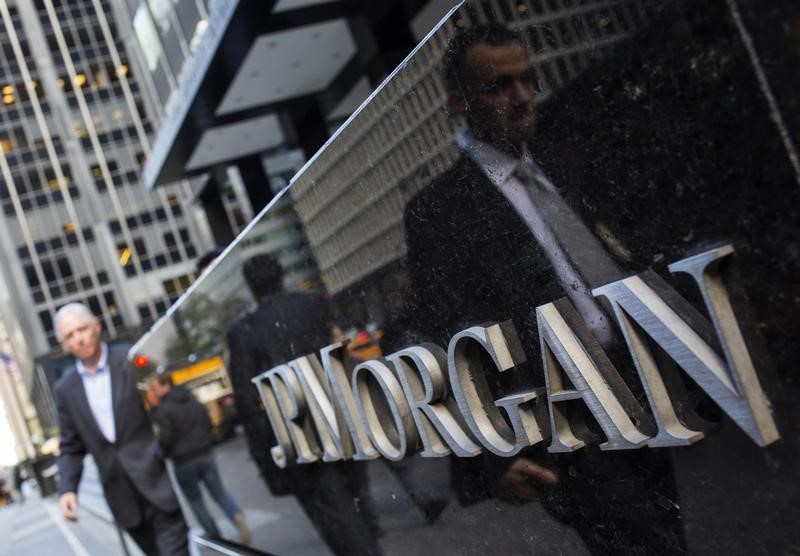By Peter Rudegeair
NEW YORK (Reuters) - Investors had hoped that the biggest U.S. banks would boost dividend payments substantially in 2015, but recent events including slumping oil prices will make it harder for banks to pay out more.
The big banks are already holding more capital than regulators have said they will need by the end of 2018. As banks begin reporting fourth-quarter earnings this week, starting with JPMorgan Chase & Co and Wells Fargo & Co on Wednesday, investors could learn that banks became even more over-capitalized in the last three months.
But hopes that some of that capital will find its way to shareholders seem likely to be unfulfilled. Expected loan losses are rising, especially in the energy sector, and trading markets are becoming more volatile, which makes bank assets riskier. Regulators are less willing to approve big increases in dividends or share buybacks when assets are riskier, analysts said.
Banks' likely difficulty in raising dividends or buying back more shares would be only the latest headache for investors. Since the 2008 financial crisis, partly caused by banks' bad lending and bond underwriting practices, banks have entered huge legal settlements and have struggled to boost their revenue. Historically low interest rates have also depressed earnings.
Paying higher dividends was supposed to be a spur to boost stock valuations in the sector.
Banks pay out a much lower percentage of their earnings than they used to. Between 1999 and 2006, big banks on average paid about three-quarters of their income out as dividends or share buy backs, according to analysts at Credit Suisse, but the ratio in the last few years has been under 50 percent.
The decline in payouts comes in large part because regulators started overseeing dividend payments and share buybacks in 2009. The Federal Reserve was looking to prevent a repeat of 2007 and 2008, where banks paid out more than they earned. Banks have trouble cutting dividends in tough times because they fear the move will signal weakness to customers and investors, further weakening their business.
Investors are unsure when that will change.
"Banks are set up to be able to pay out more and they will do that — we just don't know when," said Tony Scherrer, director of research at Smead Capital Management, which owns shares in Bank of America Corp, Wells Fargo & Co and JPMorgan Chase & Co.
The biggest banks are seeking approval for their 2015 dividend plans with the Federal Reserve now, and will learn the results in March.
Of the largest U.S. banks, Citigroup Inc's shareholders may be the most disappointed with low dividend increases in 2015, analysts said. Citigroup has paid the lowest percentage of its profit as dividends to investors of any of the big banks since the crisis — just 1 percent in 2013. Citigroup declined to comment.
RISKIER BUSINESS
Before the last few weeks, investors and bank executives had been hopeful about higher payouts because of the increase in capital.
Loan defaults have been falling thanks to an improving U.S. economy, particularly for commercial loans, giving regulators more comfort about banks paying out earnings to investors. For instance, in the third quarter Wells Fargo not only did not lose a single dollar on commercial loans that went bad; in fact, it recovered $24 million from borrowers who had defaulted.
But energy companies have accounted for a growing share of commercial loans at many banks, and with oil prices having fallen 50 percent in recent months, investors are concerned about rising loan defaults in the coming year.
"Commercial losses are unsustainably low," said Ryan Nash, a bank analyst at Goldman Sachs Group Inc last week. "Somebody is going to have an impact from the fact that oil prices are $47 a barrel just now. It's hard to say who it is."
Trading assets have become riskier as well, as prices across markets have oscillated wildly. From the beginning of 2013 through most of 2014, the average daily trading range for the Standard & Poor's 500 index was 15 points; in the last three weeks it has jumped up to a daily average of 25 points.
Treasury yields have fallen unexpectedly as well, which in addition to making bond markets more volatile, also cuts the income banks can earn on the portfolios of securities they hold, and drives down some lending rates.
Any increases in credit losses and market riskiness will have a big effect on how regulators look at bank's safety levels. The Federal Reserve adjusts banks' capital requirements based on the riskiness of their assets, using an adjustment known as "risk-weighted assets," with riskier assets requiring more capital.
Charlie Peabody, a veteran bank analyst at Portales Partners, calculates that a 30 percent increase in Citigroup's risk-weighted assets - an event he thinks is likely over the next two years - would reduce the bank's regulatory capital ratios from 10.47 percent to 8.05 percent, below its internal minimum of 9.5 percent and too low to expand dividends or repurchases.
A decline in expected payouts for Citigroup could be a big problem for its shares. A poll of investors at a November conference hosted by Bank of America Corp found that two-thirds believed the biggest catalyst for Citigroup's stock price going forward was getting permission from regulators to return more capital to shareholders.
